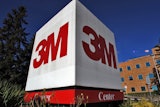British researchers argue a rapid increase in the industrial chemical dichloromethane and similar substances is contributing to a depletion of the Earth's ozone layer.
In a study published in the journal Nature Geoscience, scientists from the University of Leeds examined the impact of dichloromethane and other so-called "very short-lived substances" — those with lives generally under six months — on the stratospheric ozone layer, which shields the planet from harmful solar radiation.
Chemicals from long-lived substances, such as chlorofluorocarbons, are principally responsible for ozone depletion and were targeted by the United Nation's 1989 Montreal Protocol in an effort to reduce those effects.
Researchers said efforts to limit CFCs and other long-lived substances remain on track, but that short-lived substances that were not included in the Montreal agreement — since they contributed little to prior ozone depletion — have increased rapidly and "could offset some of the benefits to the ozone layer provided by the Montreal Protocol."
The report particularly concerns dichloromethane, a man-made compound with a wide variety of industrial uses, including as a paint remover, cleaning agent, solvent and fumigant. It is used in agriculture and food production, as well as the production of chemicals, electronics, metals, pharmaceuticals, plastics, textiles and refrigeration products.
Their simulations found though ozone loss due to short-lived substances was relatively small compared to long-lived substances, the short-lived substances reduced ozone four times as efficiently as long-lived gases. The study also found short-lived substances tend to break down ozone at lower altitudes, triggering a greater effect on the Earth’s climate.
“It is uncertain what is driving this growth. However, it could be partly due to the fact that dichloromethane is used in the manufacturing process of some HFCs, the 'ozone-friendly' gases which were developed to replace CFCs," said Ryan Hossaini, the study's lead author. "This would mean, ironically, that production of ozone-friendly chemicals is actually releasing some ozone-destroying gases into the atmosphere."
Study co-author Martyn Chipperfield said officials should determine the sources of those substances and continue to monitor their prevalence in the atmosphere, noting increasing dichloromethane “will lead to uncertainty in our future predictions of ozone and climate.”
Study: Industrial Chemical Contributes to Ozone Loss
The report particularly concerns dichloromethane, which has a wide variety of industrial uses, including as a paint remover, cleaning agent, solvent and fumigant.
Feb 18, 2015
Read Next
Latest in Chemical Processing
Jury Awards $332 Million to Man in Monsanto Case
November 3, 2023
EPA Boosts Biofuel Requirements
June 22, 2023
Bayer Owes $6.9M Over Weed Killer Advertising
June 16, 2023























